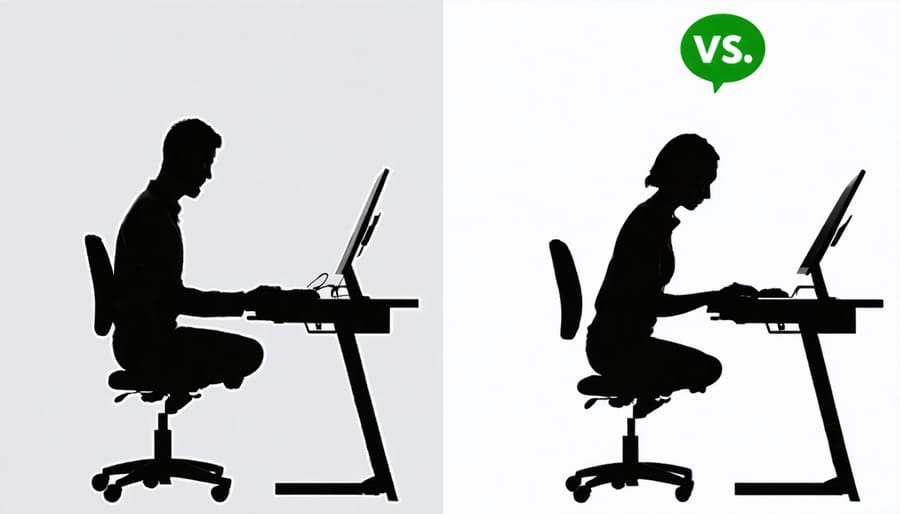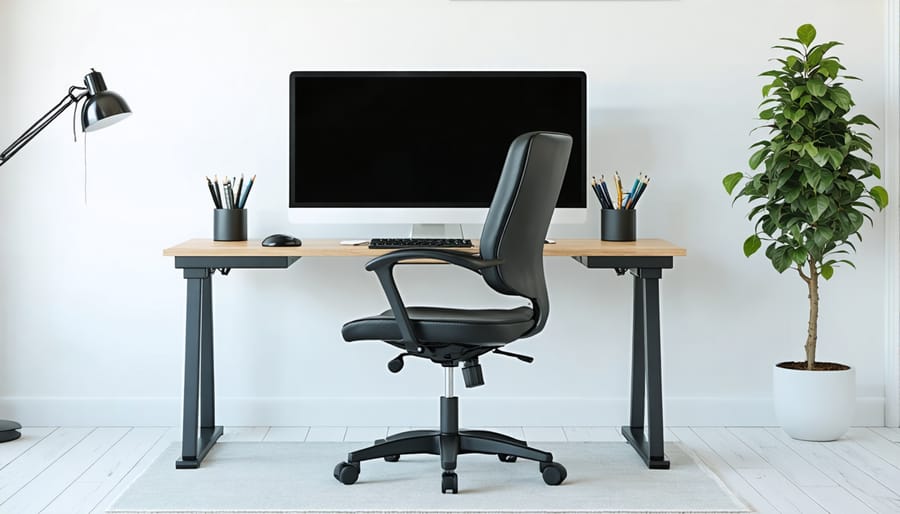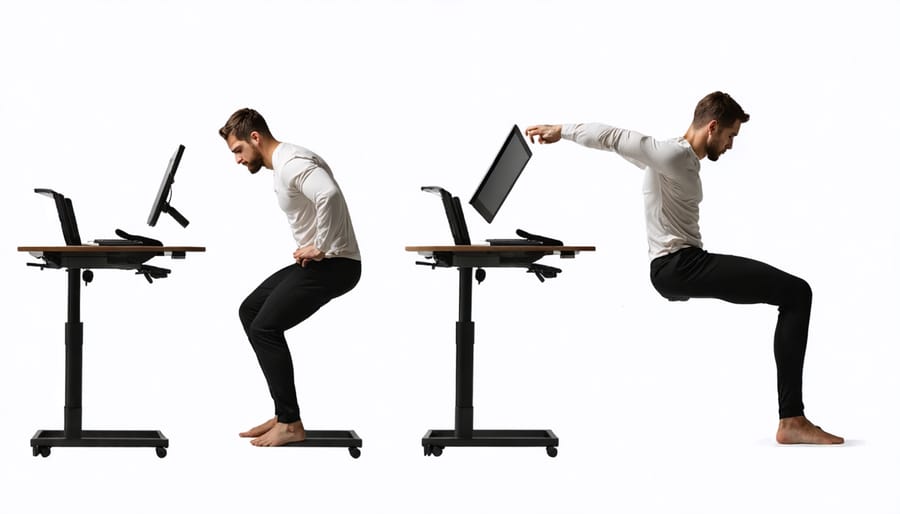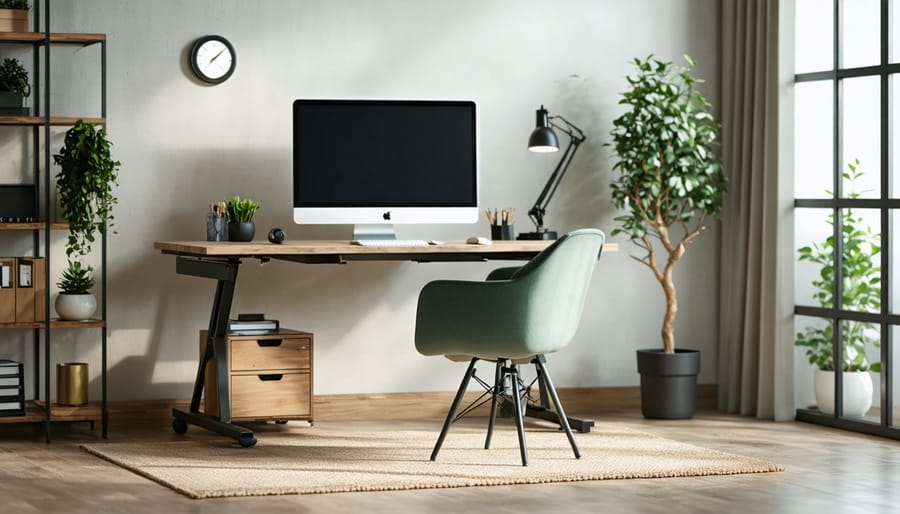Transform your workspace into a health-promoting environment by integrating ergonomic design principles that support both physical comfort and mental well-being. Position your monitor at arm’s length with the top edge at eye level, adjust your chair height so feet rest flat on the floor, and maintain neutral wrist positions while typing to prevent repetitive strain injuries. Create adaptable workstations that seamlessly transition between sitting and standing positions – essential for achieving remote work success in today’s hybrid environments.
Strategic lighting placement, incorporating both natural daylight and adjustable task lighting, reduces eye strain and enhances focus throughout the workday. Consider the flow of movement in your workspace, ensuring frequently used items remain within easy reach while maintaining proper posture. These evidence-based ergonomic principles apply equally to home offices and corporate environments, promoting long-term health benefits and increased productivity through thoughtful design choices.
By prioritizing ergonomic design, organizations and individuals invest in preventing musculoskeletal disorders, reducing workplace injuries, and fostering environments that support sustained physical and mental performance. This proactive approach to workspace design directly impacts employee well-being, engagement, and overall organizational success.
The Hybrid Work Challenge
Common Pain Points
Poor ergonomic design can lead to several significant health challenges that affect both physical and mental well-being. Many Canadians report experiencing neck and shoulder pain from prolonged forward head posture, particularly when using laptops or tablets without proper support. Lower back pain is another common issue, often resulting from inadequate lumbar support and poor sitting posture.
Wrist and hand problems, including carpal tunnel syndrome, frequently develop from incorrect keyboard and mouse positioning. Eye strain and headaches are increasingly common due to improper screen height and poor lighting conditions, especially when implementing digital well-being strategies becomes challenging.
Mental health impacts shouldn’t be overlooked either. An uncomfortable workspace can increase stress levels, reduce productivity, and lead to feelings of frustration and anxiety. Poor ergonomic setups often result in reduced focus and mental fatigue, particularly during long workdays. These issues can be especially pronounced in home office environments where proper ergonomic furniture may be lacking.
The good news is that most of these pain points can be addressed through thoughtful ergonomic design and regular workspace adjustments.
Essential Ergonomic Elements for Your Workspace

Seating Solutions
Choosing the right chair is fundamental to maintaining good posture and preventing discomfort during long work hours. Look for chairs with adjustable height, allowing your feet to rest flat on the floor while your thighs remain parallel to the ground. The seat depth should let you sit with your back against the backrest while maintaining 2-3 fingers’ width of space between the back of your knees and the seat edge.
A proper ergonomic chair should feature lumbar support that aligns with the natural curve of your lower back. The backrest should be adjustable to maintain a slight recline of 100-110 degrees, which helps reduce pressure on your spine. Armrests should be positioned to support your elbows at a 90-degree angle when typing, keeping your shoulders relaxed.
Consider chairs with breathable materials and adequate cushioning to maintain comfort throughout the day. If your budget allows, invest in chairs with dynamic features like synchronized tilt mechanisms, which encourage subtle movements that help prevent muscle fatigue.
Remember to adjust your chair settings regularly and stand up every 30-60 minutes to promote blood circulation. Even the best chair can’t compensate for prolonged sitting, so incorporate movement into your workday routine. When working from home, avoid using dining chairs or sofas as permanent workspace seating, as they typically lack proper ergonomic support.
Desk Setup and Monitor Positioning
Creating an ergonomic desk setup starts with proper positioning of your work surface and monitor. Your desk height should allow your forearms to rest parallel to the floor when typing, with elbows bent at approximately 90 degrees. For most people, this means a desk height between 73-76 centimetres (29-30 inches).
Monitor placement is crucial for preventing neck strain and eye fatigue. Position your screen directly in front of you, about an arm’s length away (50-70 centimetres). The top of the monitor should be at or slightly below eye level, tilted back 10-20 degrees. If you use a laptop, consider investing in a separate keyboard and laptop stand to achieve proper screen height.
For dual-monitor setups, place your primary screen directly in front of you and the secondary monitor slightly angled beside it. If you use both screens equally, center yourself between them to minimize neck rotation.
Pay attention to screen glare, which can cause eye strain. Position your monitor perpendicular to windows when possible, and use adjustable task lighting to reduce reflections. If you can’t avoid glare, consider using an anti-glare screen filter.
Remember to adjust your setup when switching between sitting and standing positions, maintaining these recommended angles and distances throughout your workday. Small adjustments can make a significant difference in your comfort and long-term health.

Keyboard and Mouse Ergonomics
Proper keyboard and mouse positioning is essential for preventing strain and maintaining comfort during long work hours. Your keyboard should be at a height where your elbows remain at roughly 90 degrees, with your forearms parallel to the floor. The keyboard should lie flat or slope slightly downward to keep your wrists in a neutral position.
When selecting a keyboard, consider models with a low profile and minimal tilt to reduce wrist strain. Split keyboards can help maintain a more natural arm position, while ergonomic keyboards with curved layouts can decrease muscle tension in your hands and forearms.
Your mouse should be positioned at the same height as your keyboard and within easy reach to prevent shoulder strain. Choose a mouse that fits your hand size comfortably – your fingers should rest naturally on the buttons without stretching. Consider using a vertical mouse, which maintains a more natural “handshake” position for your wrist.
To reduce repetitive strain, alternate between different input methods when possible. This might include using keyboard shortcuts, a trackpad, or even voice commands for certain tasks. Take regular breaks every 30 minutes to stretch your hands and wrists.
For additional support, use a wrist rest for both your keyboard and mouse, but remember to float your wrists while typing rather than resting them continuously on the support surface.
Portable Ergonomic Solutions
As more Canadians embrace hybrid work arrangements, having portable ergonomic solutions becomes essential for maintaining work-life balance and physical comfort across different workspaces. These mobile-friendly tools and adjustments help ensure consistent ergonomic support wherever you choose to work.
Start with a lightweight laptop stand that folds flat for easy transport. This simple tool helps position your screen at eye level, preventing neck strain. Pair it with a compact wireless keyboard and mouse to maintain proper arm positioning and reduce wrist tension.
A travel-sized lumbar support cushion can transform any chair into a more ergonomic seat. Look for ones made with memory foam that can be compressed for easy packing. Similarly, a portable footrest can help maintain proper posture and improve circulation when working at different desks.
Consider investing in an adjustable tablet or phone stand to keep your devices at eye level during video calls or when reviewing documents. This prevents the common “tech neck” associated with looking down at screens for extended periods.
For those who alternate between sitting and standing, portable standing desk converters are now available in lightweight, collapsible designs. These can be set up quickly on any flat surface, offering flexibility in your working position throughout the day.
Don’t forget about lighting – a compact LED desk lamp with adjustable brightness and color temperature can help reduce eye strain when working in different lighting conditions. Many modern options are USB-powered, making them perfect for mobile use.
Keep these portable solutions organized in a dedicated work bag or backpack with proper compartments. This not only protects your equipment but also makes transitions between workspaces smoother and more efficient. Remember to set up your mobile workspace following the same ergonomic principles you use at your primary desk to maintain consistent comfort and support throughout your workday.
Creating Movement-Friendly Spaces
Standing Desk Integration
Standing desks have become a valuable tool in creating healthier workspaces, but their effectiveness depends on proper integration and use. Start by positioning your standing desk in an area with adequate space for movement and ensure all essential items remain within easy reach when both sitting and standing.
The key to successful standing desk use is gradual adaptation. Begin with 20-minute standing intervals, two to three times per day, and gradually increase duration as your body adjusts. Most health experts recommend aiming for a 1:1 ratio between sitting and standing time throughout your workday.
To maximize benefits, maintain proper posture while standing: keep your screen at eye level, elbows at 90 degrees, and wrists straight. Use an anti-fatigue mat to reduce pressure on your feet and legs, and wear supportive footwear. Consider installing a footrest to shift weight between legs periodically.
Remember that standing all day isn’t the goal – movement is. Set reminders to switch positions regularly, and incorporate gentle stretches during transitions. When selecting a standing desk, choose one with smooth height adjustment mechanisms and preset height options to ensure consistent ergonomic positioning.

Mental Health and Workspace Design
The impact of workspace design on mental well-being cannot be overstated, especially as more Canadians navigate between home and office environments. A thoughtfully designed ergonomic workspace does more than protect physical health – it creates an environment that supports psychological wellness and reduces stress. Research shows that mental health in remote work is significantly influenced by our immediate surroundings.
Natural lighting, proper organization, and comfortable furniture all contribute to reduced anxiety and improved mood. When workstations are arranged to minimize visual clutter and maximize natural light exposure, employees report better focus and decreased stress levels. Including plants and other natural elements in the workspace design has been shown to reduce mental fatigue and increase creativity.
Ergonomic design also promotes a sense of control and autonomy, essential factors for mental well-being. Adjustable furniture and customizable workspace elements allow individuals to create environments that suit their personal needs and preferences. This sense of control helps reduce workplace anxiety and increases job satisfaction.
Color choices play a crucial role too – soft, natural tones can create a calming atmosphere, while strategic use of brighter colors can enhance energy and motivation. The incorporation of quiet spaces or focus areas within the workspace design provides opportunities for mental breaks and stress relief when needed.
Remember that good ergonomic design should address both physical comfort and psychological needs. When employees feel supported by their environment, they’re better equipped to manage work-related stress and maintain positive mental health throughout the workday.
Implementing ergonomic design principles in your workspace isn’t just about following rules – it’s about creating an environment that supports your health, productivity, and well-being. By making thoughtful adjustments to your workstation setup, choosing appropriate furniture and equipment, and maintaining good posture habits, you can significantly reduce the risk of musculoskeletal disorders and other work-related health issues.
Remember that ergonomic design is not a one-size-fits-all solution. Take time to assess your individual needs and make adjustments that work best for you. Start with the basics like proper chair height, monitor positioning, and keyboard placement, then fine-tune these elements based on your comfort and work style.
Make ergonomic improvements a gradual process, and pay attention to how your body responds to changes. Regular movement breaks, stretching exercises, and workplace modifications all contribute to a healthier work environment. Whether you’re working from home or in an office setting, prioritizing ergonomic design is an investment in your long-term health and comfort.
Take action today by implementing even small changes – your body will thank you for years to come.

